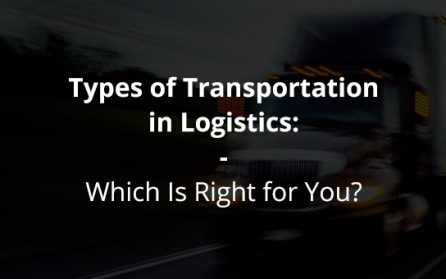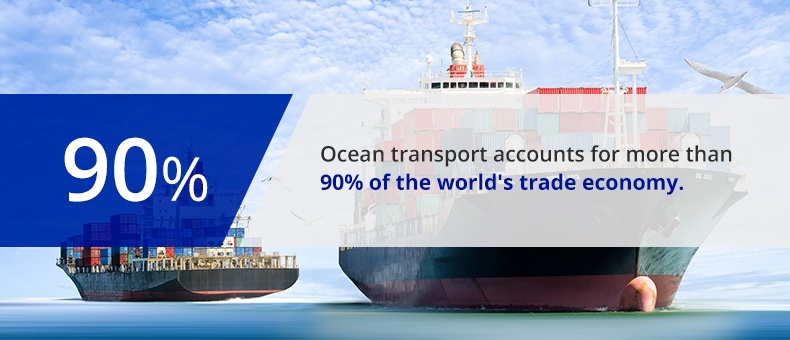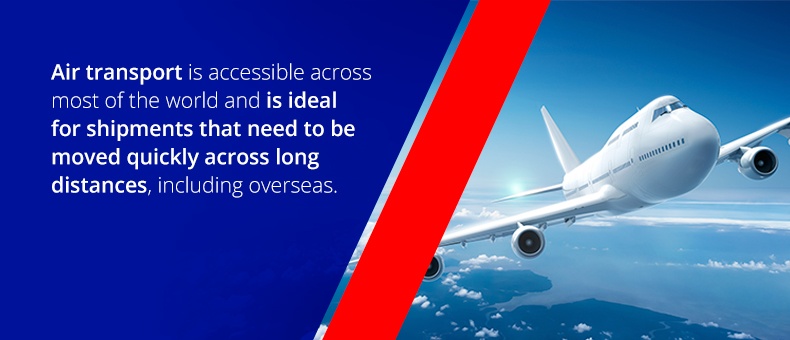Blog
Types of Transportation in Logistics: Which Is Right for You?

The four primary modes of transportation in logistics are shipments by truck, ship, train and plane — also known as road, maritime, rail and air shipments. While each of these modes of transportation has unique benefits, knowing which method is right for your business requires careful consideration.
In this guide, we’ll take a look at each of these four types of logistics transportation and discuss potential benefits and possible drawbacks of each, as well as an alternative shipping option, known as intermodal transportation.
How to Choose the Best Type of Logistics Transportation for Your Company
In a world where fast shipping is not just a luxury, but an expectation, choosing the right type of logistics transportation for your company is crucial for the success of your business, the safety of your product and the happiness of your customers. Before you choose a logistics transportation method, consider the following factors and use the information to guide your decision making:
The Product
First, analyze the shipment you are transporting. Is your product hazardous, perishable or challenging to handle? What are the dimensions of the shipping container? This information is critical for choosing a shipping method that can accommodate your products within budget.
Location
Next, consider two locations — where the shipment is leaving and its final destination:
- Shipping origin: Where are you shipping from? Where you or your products are located is important, as it’s the starting point for your mileage tracking. Do you have access to maritime ports, railroads or airports?
- Borders:Are you shipping across country borders and require special clearance? What natural borders will your shipment cross? While one method of transportation might be the most suitable option for your product, it may be more expensive and time-consuming than other means if you are not located within easy access to these options.
- Shipping destination: Where are you shipping to? The shipping destination is one of the most significant factors to consider. Calculate the total shipping distance, factoring in all stops and checkpoints.
- The consumer: Are you shipping to an individual or a business? This might indicate which speed or method is preferable.
Special Considerations
Finally, take into account the cost and difficulty of any special considerations your shipment requires:
- Time: The time of year you’re moving your product — during the holiday season, for instance — might impact overall shipment times.
- Urgency: How urgent is your shipment? Can you afford a delay — both financially and in the eyes of your consumers?
- Budget: What is your transportation budget? Convenience is great, but staying within your budget is crucial for longterm operations.
- Existing relationships: Examine the resources to which you already have access. What shipping and logistics companies do you have a relationship with already? What services do they offer?
Comparing Logistics Transportation Methods
No matter how you ship, there are advantages and downsides to each method. The secret to finding the best transportation option for your business is understanding these differences. Here is a breakdown of each transportation method and its pros and cons:
1. Truck Freight — Road Transportation
Road transportation has come a long way since the days of horse and wagon shipments. Truck freight alone accounts for more than 54% of all northern border freight between Canada and the United States. Truck transportation is ideal for industries that require quick, small shipments directly to a business, warehouse or consumer’s door and is equipped to handle possible delays.
The top three commodities in trans-border truck shipping are computers and computer parts, electrical machinery and vehicles and motor parts. Other industries that rely on truck freight include grocery and retail, eCommerce, construction and agriculture.
The top benefits of truck freight include: >
- Implements fewer restrictions: Compared to other modes of transportation — especially air transport — there are far fewer restrictions for truck freight, including heavy or hazardous materials. Trucks are also easier to track than other modes of transportation, due to built-in navigational systems and real-time tracking abilities, so you always know exactly where your shipment is located.
- Costs less than air and ship transportation: Truck freight is very economical compared to air and ship transportation because associated expenses, such as fuel and truck maintenance, are far less costly.
- Allows for more accessibility: Road transportation is highly accessible. Most companies have easy access to a major highway system, while not every company has access to railroads, airports or ships for other forms of transportation.
- Offers more options: With truck freight, you have limitless options available to you. There are many different specialized trucking companies that can accommodate perishable, hazardous or oversized goods. Depending on the shipping company, you can also choose from things like parcel, full truck and less than truckload shipping. When you only need to ship a small number of packages, parcel shipments are an excellent option. Similar to parcel shipping is less than truckload (LTL) shipping. LTL freight services are ideal when your shipment is less than a truckload but too large or oddly shaped for parcel shipments. When compared to full truckload shipments, parcel and LTL provide an enticing level of flexibility that other transportation methods cannot.
- Allows for door-to-door shipment: Perhaps the most significant benefit associated with truck freight is the ability to ship a product directly to the consumer’s front door. Although last-mile delivery is not always available due to the type and size of the product or final destination, the possibility of door-to-door shipment is why many companies opt for truck freight over other methods.
Despite these numerous benefits, there are a few important factors to consider before selecting truck freight, such as:
- Time: Truck freight can take longer and is more susceptible to shipment delays than other methods. The average truck travels roughly 50 to 60 miles per hour on major roadways. Other factors, such as road closures, bad weather or heavy traffic, can also have unpredictable impacts on delivery times.
- Control Due to how truck freight works, you do not have as much control over how your products are handled. Road travel can be rough on some shipments, and some companies may mishandle your product — that’s why it’s crucial to work with a trusted logistics company backed by awards and client testimonials.
2. Ship — Marine Transportation
Ocean transport accounts for more than 90% of the world’s trade economy. The United States alone relies on water transportation for almost 70% of all international merchandise trade. Whenever your business requires transport for heavy, cumbersome loads — or country to country shipping — ship transportation is usually the way to go.
Compared to air transportation, ships are capable of carrying immensely heavier loads for a fraction of the cost. It is the preferred transportation for large items shipped in bulk, such as metals, agriculture products, building supplies and others that cannot be reasonably accommodated by plane.
The benefits of maritime transportation include:
- Accommodates more space and weight: Cargo ships range in length, and can carry thousands of tons of weight. For this reason, ships are often the best — and only — option for oversized products or bulk quantities that must move at the same time.
- Costs less than air transportation: Marine transportation is often a more economical choice than air transport due to the lower cost of fuel. Cargo ships operate on a set schedule, so there is also less opportunity for costly shipping delays.
- Enhances the safety of the shipment: Because ships operate on a set route and planned schedule, your shipment will go through minimal handling. Most of the time, it will be securely stored in a slow-moving vessel, which is preferable for easily damaged goods.
Sea transportation may not always be the most economical or accessible choice, depending on the location of your warehouse. However, the most significant factor to consider about maritime transit is how long it takes to move a shipment:
- Speed: Although ships are capable of carrying much bigger loads than other transportation methods, maritime shipping takes much longer. It is not usually the preferred shipping method for businesses that rely on speedy delivery.
3. Train — Rail Transportation
Since the invention of the railway, trains have played an important part in trade and logistics around the world. As of January 2020, rail freight accounted for roughly 15% of northern border freight between the United States and Canada, with the top three commodities being motor vehicles and parts, mineral fuels and plastics. Rail transport is ideal for companies who require fast, scheduled ground freight.
Some benefits of trail transport are:
- Offers more carrying capacity: Trains can transport heavy, bulk cargo — such as coal — over long distances. They can handle more weight than truck transportation.
- Reduces the chances of delays: Trains operate on a fixed schedule, making them a predictable and reliable form of transportation. Because railroads operate independently, train shipments are often less prone to delays that plague truck freight, like traffic jams or inclement weather.
- Minimizes its environmental impact: Although the environmental impact of a shipment depends on a combination of several different factors, trains tend to be less impactful than trucks, planes and ships because they require less fuel to operate.
The two main factors to consider with rail transport are:
- Transit time: Rail transport is slower than truck and air freight, and they often require multiple transfers throughout the shipment process.
- Accessibility: Not every area has access to railroad tracks, so rail transport almost always requires other forms of transportation to move products. Rail transportation is often combined with truck freight for efficient delivery.
4. Plane — Air Transportation
Air transport is the newest shipping method, but it is often the best choice if you want fast, uncompromising delivery. Air transport is accessible across most of the world and is ideal for shipments that need to be moved quickly across long distances, including overseas. Air transportation also has a vast scope compared to rail and ship freight, as it is an ever-expanding industry with several thousand airports and landing strips in operation across the globe.
The two most significant benefits of air transport are:
- Allows for speedy deliveries: Despite the possibility of occasional flight delays, air transport is significantly faster than ship, truck or plane delivery under most circumstances. Additionally, airplanes operate on a fixed schedule. This reliability is an asset when arranging shipment, particularly for perishable goods that require prompt — often overnight — delivery.
- Offers enhanced security: Planes offer this speed with little to no compromise to the quality of the product, providing optimal protection and safe handling due to rigorous flight checkpoints and little interference during flight.
However, a few disadvantages to consider about air transport are:
- Cost: Air transport is more expensive than truck transport due to the higher cost of fuel and additional expenses like tickets, maintenance, checkpoints, special handling fees for certain materials, shipping containers and more. When ground logistics are an option, and guaranteed quick delivery is not required, trucks are often the more economical decision. For companies who can afford the cost and rely on fast shipments, air transport is ideal.
- Limitations: Due to the nature of air transport, there are certain limitations in place that some companies may find difficult to navigate, including size, weight and product restrictions. Airplanes have a set weight capacity that they cannot exceed, and many materials are too hazardous to transport via flight.
What Is Intermodal Transportation?
Intermodal transportation is when a shipment requires two or more types of transportation to reach its final destination. This is typically used with rail and ship transport, which often require trucks to carry shipments from the railway or port. Intermodal transportation is ideal for shipments that are not of immediate value that have to travel a long distance.
In most cases, products remain inside the same shipping container throughout the entire process. In other cases, however, your products might be transferred from one shipping container to another. Always discuss this with your transportation and logistics provider to make sure you are packaging your products accordingly. You should also keep in mind the different restrictions and requirements across all modes of transportation. For example, just because your shipment fits within rail transportation guidelines, does not mean it will qualify for air travel.
Contact Purolator International for Transportation Services
When you need fast, efficient transportation for your company, look no further than Purolator International. At Purolator International, we provide our clients with hassle-free and on-time express, freight and parcel shipping solutions primarily from the U.S. to Canada. When you ship with Purolator International, you have access to an extensive logistics network with flexible solutions created to meet your company’s individual transportation needs.
Contact us to learn more about the types of logistics transportation methods we offer, and what options are best suited for your company and product. You can also browse our available services online.



